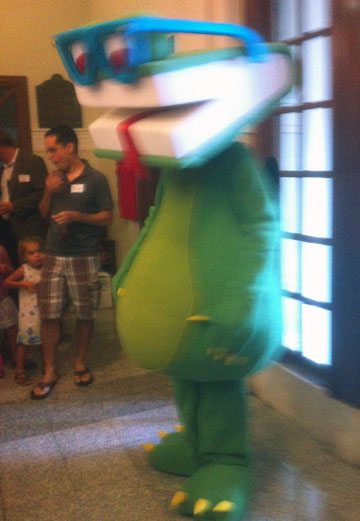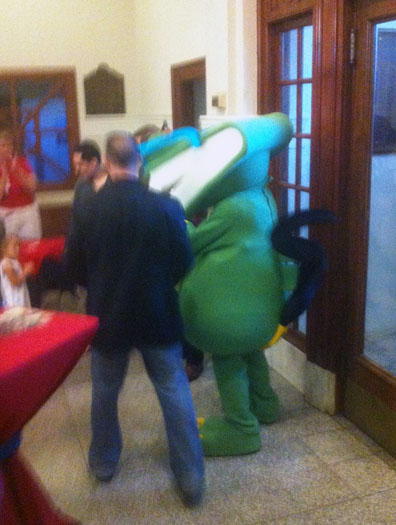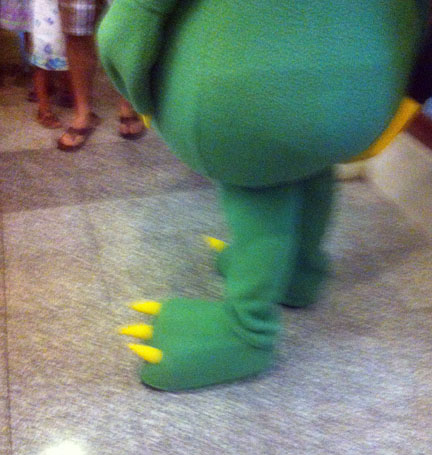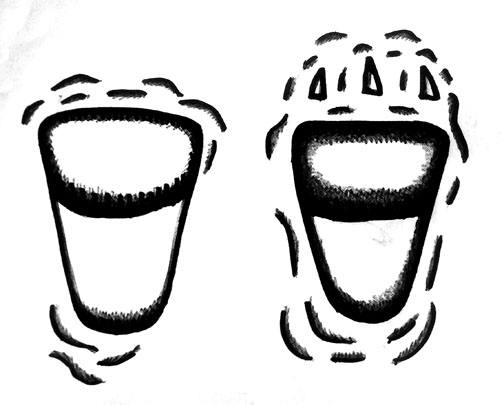The AJC-Decatur Book Festival, an annual event held on Labor Day weekend in my hometown of Decatur, Georgia, begins tonight with a poetry reading from Natasha Trethewey, the new U.S. Poet Laureate and a colleague of mine at Emory University. The festival is one of the largest independent book fairs in the U.S., featuring readings by hundreds of fiction and non-fiction authors, poets, illustrators, spoken-word artists, and other people interested in all things literary, as well as having lots of books for sale.
But along with the authors and other written-word enthusiasts will be an elusive figure, one you may or may not notice among the 80,000 or so people, but whose visage will preside over activities as an iconic talisman. Known as Bookzilla, he – or she, as its gender is uncertain – is apparently the result of a genetic experiment gone awry, mixing the traits of a near-sighted human, theropod dinosaur, and book (pre-Kindle version).
 A rare photo of Bookzilla, making a rare appearance in downtown Decatur, Georgia this past June. Note the physical characteristics denoting a voraciously studious consumer of words, and one that doesn’t care whether a book is fiction, non-fiction, new, or used.
A rare photo of Bookzilla, making a rare appearance in downtown Decatur, Georgia this past June. Note the physical characteristics denoting a voraciously studious consumer of words, and one that doesn’t care whether a book is fiction, non-fiction, new, or used.
Fortunately, as an ichnologist, I don’t have to rely on sightings to know where Bookzilla might be or what he/she was doing at the festival. Bookzilla, much like other cryptozoological beings who are infrequently observed in nature, leaves many traces from his/her behavior. So when I spotted Bookzilla in downtown Decatur earlier this year, I made sure to observe his/her behavior very carefully and take several photos of him/her to aid in my ichnological predictions of Bookzilla traces. After all, every trace is a function of what I often call the “Holy Trinity” of ichnology: an tracemaker’s anatomy, its behavior, and the substrate preserving its traces.
 Another view of Bookzilla, giving an overall view of its form and behavior, thus lending to a better appraisal of its tracemaking abilities. An especially important feature to keep in mind is his/her large, forward-leaning, rectangular head, which should cause deeper impressions in the front halves of his/her tracks. Also note the small child cowering nearby, yet being reassured by her father that Bookzilla, and by default books and the knowledge they contain, are to be embraced, not feared.
Another view of Bookzilla, giving an overall view of its form and behavior, thus lending to a better appraisal of its tracemaking abilities. An especially important feature to keep in mind is his/her large, forward-leaning, rectangular head, which should cause deeper impressions in the front halves of his/her tracks. Also note the small child cowering nearby, yet being reassured by her father that Bookzilla, and by default books and the knowledge they contain, are to be embraced, not feared.
 Close-up view of the foot morphology of Bookzilla. Note the unusual blend of a plantigrade mode, with metatarsals in contact with the walking surface, combined with a trapezoidal (but symmetrical) outline to his/her foot, as well as three sharp unguals (claws) elevated well above the surface by excessive padding in the foot. Such feet, particularly when moved by a vertically oriented biped such as Bookzilla, will result in distinctive trackways that could never be confused with, say, those of a person wearing a clumsy costume.
Close-up view of the foot morphology of Bookzilla. Note the unusual blend of a plantigrade mode, with metatarsals in contact with the walking surface, combined with a trapezoidal (but symmetrical) outline to his/her foot, as well as three sharp unguals (claws) elevated well above the surface by excessive padding in the foot. Such feet, particularly when moved by a vertically oriented biped such as Bookzilla, will result in distinctive trackways that could never be confused with, say, those of a person wearing a clumsy costume.
Based on this admittedly limited sample of Bookzilla’s anatomy and behavior, I can nonetheless reasonably hypothesize what sorts of tracks and trackway patterns Bookzilla would form during normal activities. In a firm substrate, such as moist sand, Bookzilla’s tracks would only register only a vague trapzoidal outline of his/her feet, and claws would not register. However, in a softer substrate, such as a saturated mud or wet cement, Bookzilla would impart shallow impressions of three claws directly in front of the trapezoidal outlines.
 Hypothesized Bookzilla tracks, which could be from either the right or left feet owing to bilateral symmetry of the foot structure. (Left) Track outline formed in relatively firm substrate, such as a moist sand, with no claws showing and with the deepest part of the track in the front half because of its weighty, tome-like head. (Right) Track outline formed in soft substrate with finer grain size and higher water content, such as mud. In this instance, claw marks will register, and the track outline will be accompanied by numerous pressure-release structures from the tracemaker deforming the sediment with application and release of foot pressure caused by forward movement. Footprint length (minus claws) = 30-35 cm (12-14 in).
Hypothesized Bookzilla tracks, which could be from either the right or left feet owing to bilateral symmetry of the foot structure. (Left) Track outline formed in relatively firm substrate, such as a moist sand, with no claws showing and with the deepest part of the track in the front half because of its weighty, tome-like head. (Right) Track outline formed in soft substrate with finer grain size and higher water content, such as mud. In this instance, claw marks will register, and the track outline will be accompanied by numerous pressure-release structures from the tracemaker deforming the sediment with application and release of foot pressure caused by forward movement. Footprint length (minus claws) = 30-35 cm (12-14 in).
A typical trackway pattern for Bookzilla should show mostly diagonal walking (right-left-right diagonal to one another), but will be punctuated by many side-by-side tracks, representing long periods of stopping and standing while reading books.
 Hypothesized Bookzilla trackway pattern, indicating alternate (diagonal) walking, typical of a biped, but also interrupted by frequent stops to look at books and read. Note claw impressions are only visible in parts of the trackway, depending on local variations in substrate conditions; in this instance, stepping into wet cement.
Hypothesized Bookzilla trackway pattern, indicating alternate (diagonal) walking, typical of a biped, but also interrupted by frequent stops to look at books and read. Note claw impressions are only visible in parts of the trackway, depending on local variations in substrate conditions; in this instance, stepping into wet cement.
Considering how Bookzilla is well known as an insatiable reader and is constantly hunting for books, no sitting traces, such as those interpreted for some theropod dinosaurs, are known, nor expected. I also cannot yet speculate about about additional traces made by Bookzilla, such as dwelling structures, toothmarks, or scat. Remarkably, his/her consumption of books does not actually result in digestive products, but instead seems to cause increased levels of cognitive pleasure.
So if you are in the Decatur-Atlanta area this weekend and attending the book festival, maybe you’ll be lucky enough to actually see Bookzilla, but you’re much more likely to spot his tracks. In the meantime, take a look at some books and enjoy all of the literary traces that are offered there.
(The AJC-Decatur Book Festival will take place in downtown Decatur, Georgia from September 1-2. The full schedule is here, and it will feature appearances and talks by well-established and emerging authors and illustrators, the latter including my wife Ruth Schowalter. If you can’t make this year’s festival, it is held on Labor Day weekend every year, so plan to make next year’s. And many thanks to Daren Wang for suggesting this several months ago as a blog post!)
